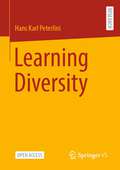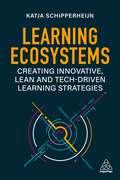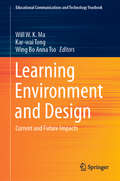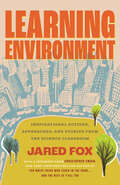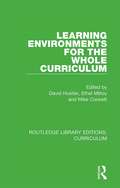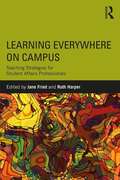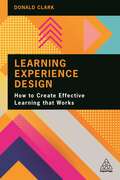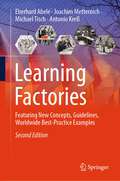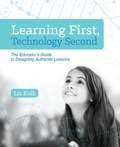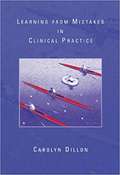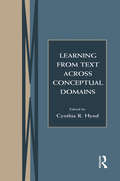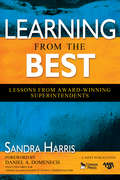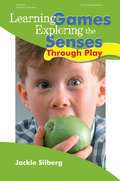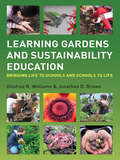- Table View
- List View
Learning Diversity
by Hans Karl PeterliniThis Open-Access-book explores diversity in its ambivalence. On the one side, we love to describe diversity as a resource for personal, social, economic, and cultural growth. On the other side, categories of differences often lead to discrimination or serve as justifications for privileges. They can cause exclusion and, conversely, promote the self-constitution of discriminated subjects and groups.The book moves within this tension of exclusion and belonging. Case studies of young ethnicized people vividly depict the interwovenness of identity-building and diversity. Theoretically, the book examines the psychosocial and anthropological conditions for constructing the Other. Sharp divisions between We and the Other, between social and national groups, and between humans and nature have devastating, life-threatening consequences. Dichotomous split-offs divide people, nations and the whole world. So, how do we deal with diversity? The author does not provide simple recipes but engages in a phenomenology of diversity that does not press life and its manifestations into categories but keeps them in a limbo of attention by affirming and doubting differences.
Learning Ecosystems: Creating Innovative, Lean and Tech-driven Learning Strategies
by Katja SchipperheijnBuilding and sustaining an organization which is nimble, adaptable, resilient and future proof is both complex and urgent. Only those with flexible and innovative Learnscapes will succeed.Learning Ecosystems explains how organizations evolve into LearnScapes where learning techniques are aligned with continuous interaction with the ecosystem they are part of. It explains how to upskill and reskill a workforce continuously in an increasingly collaborative and tech-enabled world. Full of practical guidance and strategic advice, this book covers how to take a lifelong approach to learning in the organization and the core competencies needed for this. It explains what to do when building a value and data-driven learning strategy and discusses the symbiosis of people and technology. This book explores lean learning, data analytics, learning technologies including artificial intelligence (AI) and the ethics of using these technologies. There is also crucial guidance on how to take a human-centric approach to innovation. Learning Ecosystems demonstrates the value of continuous improvement and offers techniques for a variety of situations including problem analyses, experimentation and algorithmic business thinking. Most importantly, it provides guidance on how to build a learning culture and a learning ecosystem throughout the company. Supported by case studies from companies including Etihad Airways, ING, ESF and FEDEX, this is essential reading from a leading learning innovator who has helped global organizations to rethink their learning strategies to achieve sustained business growth.
Learning Engineering Toolkit: Evidence-Based Practices from the Learning Sciences, Instructional Design, and Beyond
by Janet Kolodner Jim GoodellThe Learning Engineering Toolkit is a practical guide to the rich and varied applications of learning engineering, a rigorous and fast-emerging discipline that synthesizes the learning sciences, instructional design, engineering design, and other methodologies to support learners. As learning engineering becomes an increasingly formalized discipline and practice, new insights and tools are needed to help education, training, design, and data analytics professionals iteratively develop, test, and improve complex systems for engaging and effective learning. Written in a colloquial style and full of collaborative, actionable strategies, this book explores the essential foundations, approaches, and real-world challenges inherent to ensuring participatory, data-driven, learning experiences across populations and contexts.
Learning Engineering Toolkit: Evidence-Based Practices from the Learning Sciences, Instructional Design, and Beyond
by Janet Kolodner Jim GoodellThe Learning Engineering Toolkit is a practical guide to the rich and varied applications of learning engineering, a rigorous and fast-emerging discipline that synthesizes the learning sciences, instructional design, engineering design, and other methodologies to support learners. As learning engineering becomes an increasingly formalized discipline and practice, new insights and tools are needed to help education, training, design, and data analytics professionals iteratively develop, test, and improve complex systems for engaging and effective learning. Written in a colloquial style and full of collaborative, actionable strategies, this book explores the essential foundations, approaches, and real-world challenges inherent to ensuring participatory, data-driven, learning experiences across populations and contexts."Introduction: What Is Learning Engineering?", "Chapter 1: Learning Engineering is a Process", and "Chapter 2: Learning Engineering Applies the Learning Sciences" are freely available as downloadable Open Access PDFs at http://www.taylorfrancis.com under a Creative Commons Attribution-Non Commercial-No Derivatives (CC-BY-NC-ND) 4.0 license.
Learning Engineering for Online Education: Theoretical Contexts and Design-Based Examples
by Chris Dede John Richards Bror SaxbergLearning Engineering for Online Education is a comprehensive overview of the emerging field of learning engineering, a form of educational optimization driven by analytics, design-based research, and fast-paced, large-scale experimentation. Chapters written by instructional design and distance learning innovators explore the theoretical context of learning engineering and provide design-based examples from top educational institutions. Concluding with an agenda for future research, this volume is essential for those interested in using data and high-quality outcome evidence to improve student engagement, instructional efficacy, and results in online and blended settings.
Learning Environment and Design: Current and Future Impacts (Educational Communications and Technology Yearbook)
by Wing Bo Anna Tso Will W. K. Ma Kar-Wai TongThis special edition of the Educational Communications and Technology Yearbook Series bears a title of “Learning Environment and Design: Current and Future Impact”. It provides a timely forum to share theoretical and practical insights in both the local and international contexts in response to the fact that new media and technologies have infiltrated and shaped the learning environments from mere physical spaces into multifaceted possibilities, impacting the ways individuals teach and learn. Designs of learning environments to harness technologies appropriately to engage learners better, as well as the roles of learners and educators play in this changing learning environment, are examples of important global issues in the discourse of the contemporary educational developments. Having gathered a diverse collection of research papers written by scholars and practitioners in the fields of education, communication and humanities across Asia, Australasia, Europe and the United States, this book gives readers a cross-cultural background on the developments of technological designs and educational practices, investigating areas in redefining of quality education; online learning and blended learning; new media in education; gamification, AI, and innovative learning technologies. Aimed to catalyze knowledge exchanges and provide fresh views on interdisciplinary research, the book sheds light on how emerging technologies can be adapted in the fields of education and communication, so as to facilitate the current and future designs of learning environments to improve learners’ performances.
Learning Environment: Inspirational Actions, Approaches, and Stories from the Science Classroom
by Jared Fox"Few people have the writing ability, education expertise, and thoughtfulness to write a book about the state of education. Jared is masterful in the classroom...and [his book] will change the landscape of education." —Dr. Christopher Emdin, New York Times best-selling author of For White Folks Who Teach in the Hood...and the Rest of Y'all Too An award-winning environmental science teacher's actionable roadmap for educators interested in making the world a classroom, even in the cityJoin award-winning New York City educator Dr. Jared Fox in—and out of—his classroom on an excursion that goes beyond books and lectures to reimagine teaching and learning. Through a blend of real-life examples and practical commentary, readers will see how Fox created localized learning opportunities for his students out of canoeing on the Bronx River, hiking in the Catskill Mountains, and other unconventional approaches.Replete with sample projects, topics, theories, and strategies, Learning Environment offers an actionable vision for reengaging students and reenergizing teachers. The book encourages K-12 STEM educators to build experiential learning into their teaching styles by:designing field trips as fieldworkpartnering with local expertsimplementing localized learning through hands-on applicationleveraging interdisciplinary instructionFox invites teachers to create dynamic, transformative educational opportunities by implementing experiential learning based in their own communities. With Fox's heartfelt wisdom and practical know-how, readers will be empowered to reconsider and redefine what teaching and learning can and should be.
Learning Environments for the Whole Curriculum (Routledge Library Editions: Curriculum #19)
by David Hustler Ethel Milroy Mike CockettOriginally published in 1991. Consisting of 18 teachers' reports on attempts to change traditional learning environments, the contributors argue for a commitment to whole curriculum planning, which embraces a variety of learning environments both inside and outside the school walls. There is a particular concern in several of the reports for lower attaining pupils and those pupils who seem to gain very little from `normal lessons'.
Learning Everywhere On Campus: Teaching Strategies For Student Affairs Professionals
by Jane Fried Ruth HarperAlthough student affairs practitioners play a key role in student learning, few are familiar with learning theories, the design of experiential education, or pedagogical theory. This edited collection describes programs in which student affairs professionals work independently or in collaboration with academic faculty and community partners to create more intentional and consistent approaches that enhance student learning. Examples, models, and case studies throughout the chapters make the theories and ideas specific and practical. Exploring educational opportunities in and outside the classroom, such as peer education, leadership development, life and career planning, civic engagement, service-learning, and study abroad, this book provides both theories and pedagogical frameworks for organizing and integrating the entire institution to promote and support learning. Drawing on multiple perspectives, Learning Everywhere on Campus shares the interventions and strategies necessary to help students learn new information, acquire skills, and understand the value of this knowledge in constructing their sense of purpose and self in the world.
Learning Everywhere on Campus: Teaching Strategies for Student Affairs Professionals
by Jane Fried Ruth HarperAlthough student affairs practitioners play a key role in student learning, few are familiar with learning theories, the design of experiential education, or pedagogical theory. This edited collection describes programs in which student affairs professionals work independently or in collaboration with academic faculty and community partners to create more intentional and consistent approaches that enhance student learning. Examples, models, and case studies throughout the chapters make the theories and ideas specific and practical. Exploring educational opportunities in and outside the classroom, such as peer education, leadership development, life and career planning, civic engagement, service-learning, and study abroad, this book provides both theories and pedagogical frameworks for organizing and integrating the entire institution to promote and support learning. Drawing on multiple perspectives, Learning Everywhere on Campus shares the interventions and strategies necessary to help students learn new information, acquire skills, and understand the value of this knowledge in constructing their sense of purpose and self in the world.
Learning Experience Design: How to Create Effective Learning that Works
by Donald ClarkHow can I create in-person learning that engages people? How can I build digital learning that is effective? How can I develop learning content that can be used remotely and ensure that the learning sticks? Learning Experience Design has the answers to all these questions and more. This book is a practical guide for all learning and development (L&D) professionals. It covers everything from what learning experience design (LXD) is, the role of the L&D professional in LXD, and what the main areas to consider when designing learning are including emotion, attention, memory, engagement, enjoyment, transfer, practice and learning retention. It includes practical advice for all areas of learning design including text, graphics, audio, visual, simulations, AR/VR, question and social design. There is also essential guidance on instructional design, UX (user experience) design and how to design effective learning analytics. The final part of the book covers design thinking, blended learning and discussion of LMSs (learning management systems), LXPs (learning experience platforms) and LRSs (learning record stores). With examples, tips, case studies and advice throughout, this is an invaluable book for anyone wanting to make an impact with their learning design and ensure knowledge, skills and performance improvement.
Learning Factories: Featuring New Concepts, Guidelines, Worldwide Best-Practice Examples
by Eberhard Abele Joachim Metternich Michael Tisch Antonio KreßThis book presents the state of the art of learning factories. It outlines the motivations, historic background, and the didactic foundations of learning factories. Definitions of the term learning factory and an updated morphological model are provided as well as a detailed overview of existing learning factory approaches in industry and academia, showing the broad range of different applications and varying contents in all continents. International learning factory best-practice examples are presented in detailed and structured manner. The state of the art of learning factories curricula design and their use to enhance learning and research as well as potentials and limitations are presented. Further research priorities and innovative learning factory concepts to overcome current barriers are offered. While today numerous learning factories have been built in industry (big automotive companies, pharma companies, etc.) and academia in the last decades, a comprehensive handbook for the scientific community and practitioners alike is still missing. The book addresses therefore both researchers in production-related areas that want to conduct industry-relevant research and education, as well as managers and engineers in industry, who are searching for an effective way to train their employees. In addition to this, the learning factory concept is also regarded as an innovative learning concept in the field of didactics.
Learning First!: A School Leader's Guide to Closing Achievement Gaps
by Dr Carolyn J Kelley James J. ShawCombine this research-based, collaborative framework with four critical dimensions of leadership to advance equity and excellence in student learning and close student achievement gaps in your school.
Learning First, Technology Second: The Educator's Guide to Designing Authentic Lessons
by Liz KolbLearning with technology does not happen because a specific tool “revolutionizes” education. It happens when proven teaching strategies intersect with technology tools, and yet it is not uncommon for teachers to use a tool because it is “fun” or because the developer promises it will help students learn. <p><p> Learning First, Technology Second offers teachers the professional learning they need to move from arbitrary uses of technology in their classrooms to thoughtful ways of adding value to student learning. <p> This book includes: an introduction to the Triple E Framework that helps teachers engage students in time-on-task learning, enhance learning experiences beyond traditional means and extend learning opportunities to bridge classroom learning with students’ everyday lives; effective strategies for using technology to create authentic learning experiences for their students; case studies to guide appropriate tech integration; and a lesson planning template to show teachers how to effectively frame technology choices and apply them in instruction.
Learning From Children Who Read at an Early Age
by Rhona Stainthorp Diana HughesLearning From Children Who Read at an Early Age is the result of a three-year research project in which the authors studied a group of children who learnt to read without being taught, from before they started school until the end of Year 2 when they were given their first National Curriculum assessments.Using this study as a framework for examining how children make progress over their time in Key Stage 1 across a range of literacy skills, the authors suggest guidelines which teachers can use to help all children progress with reading.
Learning From Data: An Introduction To Statistical Reasoning
by Arthur Glenberg Matthew AndrzejewskiLearning from Data focuses on how to interpret psychological data and statistical results. The authors review the basics of statistical reasoning to helpstudents better understand relevant data that affecttheir everyday lives. Numerous examples based on current research and events are featured throughout.To facilitate learning, authors Glenberg and Andrzejewski: Devote extra attention to explaining the more difficult concepts and the logic behind them Use repetition to enhance students’ memories with multiple examples, reintroductions of the major concepts, and a focus on these concepts in the problems Employ a six-step procedure for describing all statistical tests from the simplest to the most complex Provide end-of-chapter tables to summarize the hypothesis testing procedures introduced Emphasizes how to choose the best procedure in the examples, problems and endpapers Focus on power with a separate chapter and power analyses procedures in each chapter Provide detailed explanations of factorial designs, interactions, and ANOVA to help students understand the statistics used in professional journal articles. The third edition has a user-friendly approach: Designed to be used seamlessly with Excel, all of the in-text analyses are conducted in Excel, while the book’s CD contains files for conducting analyses in Excel, as well as text files that can be analyzed in SPSS, SAS, and Systat Two large, real data sets integrated throughout illustrate important concepts Many new end-of-chapter problems (definitions, computational, and reasoning) and many more on the companion CD Online Instructor’s Resources includes answers to all the exercises in the book and multiple-choice test questions with answers Boxed media reports illustrate key concepts and their relevance to realworld issues The inclusion of effect size in all discussions of power accurately reflects the contemporary issues of power, effect size, and significance. Learning From Data, Third Edition is intended as a text for undergraduate or beginning graduate statistics courses in psychology, education, and other applied social and health sciences.
Learning From Data: An Introduction to Statistical Reasoning using JASP
by Arthur M. Glenberg Matthew E. AndrzejewskiThis fully updated fourth edition explores the foundations of statistical reasoning, focusing on how to interpret psychological data and statistical results. This edition includes three important new features. First, the book is closely integrated with the free statistical analysis program JASP. Thus, students learn how to use JASP to help with tasks such as constructing grouped frequency distributions, making violin plots, conducting inferential statistical tests, and creating confidence intervals. Second, reflecting the growing use of Bayesian analyses in the professional literature, this edition includes a chapter with an introduction to Bayesian statistics (also using JASP). Third, the revised text incorporates adjunct questions, that is, questions that challenge the student’s understanding, after each major section. Cognitive psychology has demonstrated how adjunct questions and related techniques such as self-explanation can greatly improve comprehension.Additional key features of the book include:• A user-friendly approach, with focused attention to explaining the more difficult concepts and the logic behind them. End of chapter tables summarize the hypothesis testing procedures introduced, and exercises support information recall and application.• The consistent use of a six-step procedure for all hypothesis tests that captures the logic of statistical inference.• Multiple examples of each of the major inferential statistical tests.• Boxed media reports illustrate key concepts and their relevance to real-world issues.• A focus on power, with a separate chapter, and power analysis procedures in each chapter.With comprehensive digital resources, including large data sets integrated throughout the textbook, and files for conducting analysis in JASP, this is an essential text for undergraduate or beginning graduate statistics courses in psychology, education, and other applied social and health sciences.
Learning From Mistakes In Clinical Practice
by Carolyn DillonThis text is a virtual handbook of classic mistakes to anticipate, work through, and grow from. It identifies, discusses and re-frames classic mistakes that beginning interviewers and clinicians are likely to make in practice by illuminating a myriad of mistakes through the use of first-hand vignettes, in-text exercises, and a systems framework. This book uses a strengths-perspective, and can serve as a companion text or as a stand-alone primer because of its elaboration of the phases, principles, strategies and methods used in the helping process.
Learning From Text Across Conceptual Domains
by Steven A. Stahl Cynthia R. Hynd Shawn M. Glynn Martha CarrThis volume is an attempt to synthesize the understandings we have about reading to learn. Although learning at all ages is discussed in this volume, the main focus is on middle and high school classrooms--critical spaces of learning and thinking. The amount of knowledge presented in written form is increasing, and the information we get from texts is often conflicting. We are in a knowledge explosion that leaves us reeling and may effectively disenfranchise those who are not keeping up. There has never been a more crucial time for students to understand, learn from, and think critically about the information in various forms of text. Thus, understanding what it means to learn is vital for all educators. Learning from text is a complex matter that includes student factors (social, ethnic, and cultural differences, as well as varying motivations, self-perceptions, goals, and needs); instructional and teacher factors; and disciplinary and social factors. One important goal of the book is to encourage practicing teachers to learn to consider their students in new ways--to see them as being influenced by, and as influencing, not just the classroom but the total fabric of the disciplines they are learning. Equally important, it is intended to foster further research efforts--from local studies of classrooms by teachers to large-scale studies that produce generalizable understandings about learning from text. This volume--a result of the editor's and contributors' work with the National Reading Research Center--will be of interest to all researchers, graduate students, practicing teachers, and teachers in training who are interested in understanding the issues that are central to improving students' learning from text.
Learning From Textbooks: Theory and Practice
by Bruce K. Britton Arthur Woodward Marilyn BinkleyIt is surprising that there is so little research on textbooks, given their centrality to teaching and learning in elementary and secondary schools. Textbooks have become a focus of political and cultural controversy, advocating a multicultural curriculum that has sparked some vigorous protests. Research is absent in this debate; therefore, questions of legitimate knowledge, the role of textbooks, textbook design, policy selection issues, and economic issues concerning the marketplace are not part of the current debate. Without insights of research on considerate text, mentioning, illustrations and so forth, the current controversy will result in publishers responding to demands for more content not less; thus, textbooks will become compendia of information that on the surface satisfy everyone. This volume demonstrates how research on important issues relative to textbook design can advance our knowledge about what makes textbooks effective learning tools, and thus inform policymakers, publishers, and those involved in textbook selection. Representing pure and applied approaches, researchers present papers on the quality of writing, the role of questions, the role of pictures and illustrations, and the role of auxiliary materials in the design of effective textbooks. The chapters provide insight into research and its application to textbook design and improvement -- stimulating others to follow this lead.
Learning From the Best: Lessons From Award-Winning Superintendents
by Sandra Harris"Provides a rare opportunity to get inside the heads of the best superintendents in the country. Harris′ book captures essential craft knowledge that every superintendent needs to succeed in the job."—Robert S. McCord, Associate Professor of Educational LeadershipUniversity of Nevada, Las Vegas"An excellent book for experienced and new superintendents. I kept coming across little nuggets and big ideas that I couldn′t wait to implement immediately."—Janie L. Nusser, SuperintendentSouth Seneca Central School District, NYWords of wisdom for achieving effective district leadership!In today′s challenging educational environment, superintendents need proven strategies that will help them lead their schools and districts successfully. This topical resource offers a collection of proven best practices from award-winning superintendents.Representing school districts with diverse populations, school sizes, and communities, 22 current and former superintendents from around the country detail in their own words the practices that have been central to their professional and districtwide success. Readers can learn from the wisdom and experience of these outstanding leaders on topics such as:Transformational leadership that provides direction for the district Community building, outreach, and effective partnershipsResponding to changing times, changing standards, and student needsDeveloping strategies for overcoming barriers to effective reformLearning From the Best is a valuable resource for new and experienced superintendents seeking to steer their districts through today′s most pressing educational issues.
Learning Futures: Education, Technology and Social Change
by Keri FacerIn the twenty-first century, educators around the world are being told that they need to transform education systems to adapt young people for the challenges of a global digital knowledge economy. Too rarely, however, do we ask whether this future vision is robust, achievable or even desirable, whether alternative futures might be in development, and what other possible futures might demand of education. Drawing on ten years of research into educational innovation and socio-technical change, working with educators, researchers, digital industries, students and policy-makers, this book questions taken-for-granted assumptions about the future of education. Arguing that we have been working with too narrow a vision of the future, Keri Facer makes a case for recognizing the challenges that the next two decades may bring, including: the emergence of new relationships between humans and technology the opportunities and challenges of aging populations the development of new forms of knowledge and democracy the challenges of climate warming and environmental disruption the potential for radical economic and social inequalities. This book describes the potential for these developments to impact critical aspects of education – including adult-child relationships, social justice, curriculum design, community relationships and learning ecologies. Packed with examples from around the world and utilising vital research undertaken by the author while Research Director at the UK’s Futurelab, the book helps to bring into focus the risks and opportunities for schools, students and societies over the coming two decades. It makes a powerful case for rethinking the relationship between education and social and technological change, and presents a set of key strategies for creating schools better able to meet the emerging needs of their students and communities. An important contribution to the debates surrounding educational futures, this book is compelling reading for all of those, including educators, researchers, policy-makers and students, who are asking the question 'how can education help us to build desirable futures for everyone in the context of social and technological change?'
Learning Games
by Scott J. Warren Greg JonesThis book provides an overview of the design and development of learning games using examples from those created by the authors over last decade. It provides lessons learned about processes, successful approaches, and pitfalls that befall developers of learning games and educational transmedia experiences. The book includes stories from the authors' lives that give context to why and how they built these products to help the reader understand whether or not building a learning game is right for them and what challenges they might face. It also gives a framework for thinking ethically about design and research when it comes to designing complex digital systems like educational games.
Learning Games: Exploring the Senses Through Play
by Jackie SilbergHow do children learn about the world around them? They touch, taste, see, smell and hear it, of course! With over 200 activities, Learning Games will delight children as they expand their learning by engaging all of their senses. The chapters are organized by each of the five senses, with a bonus chapter of multi-sensory activities. The games and activities are designed to help children identify and use their senses-essential tools for understanding the world. Games Include: Partner Listening Paper Plate Shakers I've Got a Rhythm Dolphin Talk Listening to Paper The Binocular Game Color My World Glowing Mobile Walking Through Africa Magnify Your Life No Hands Fingerpaint with Textures Nose, Nose Smelly Walk Tongue Bumps Sweet or Sour Tasting in Space Let's Taste Red Taste Picture Book Body Part Senses Senses for the Hand
Learning Gardens and Sustainability Education: Bringing Life to Schools and Schools to Life
by Jonathan Brown Dilafruz WilliamsOffering a fresh approach to bringing life to schools and schools to life, this book goes beyond touting the benefits of learning gardens to survey them as a whole-systems design solution with potential to address myriad interrelated social, ecological, and educational issues. The theoretical and conceptual framework presented creatively places soil at the center of the discourse on sustainability education and learning garden design and pedagogy. Seven elements and attributes of living soil and learning gardens are presented as a guide for sustainability education: cultivating a sense of place; fostering curiosity and wonder; discovering rhythm and scale; valuing biocultural diversity; embracing practical experience ; nurturing interconnectedness. The living soil of learning gardens forms the basis of a new metaphoric language serving to contest dominant mechanistic metaphors presently influencing educational discourse. Student voices and examples from urban schools provide practical understanding of how bringing life to schools can indeed bring schools to life.
